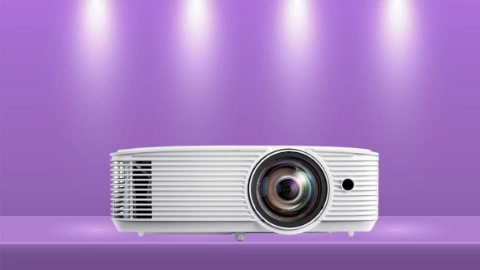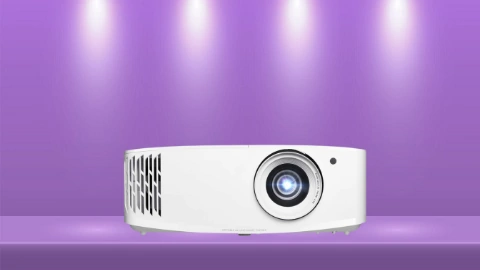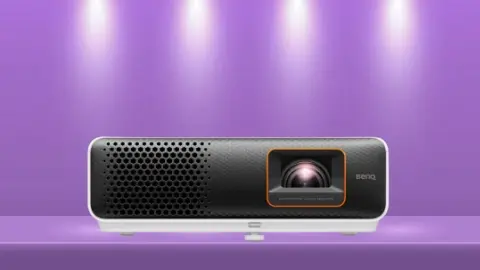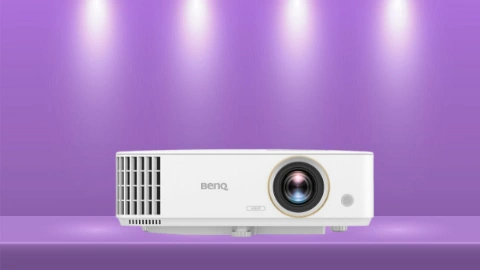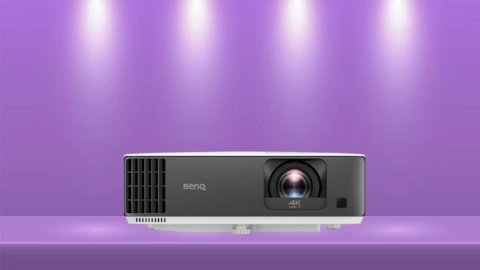Looking at all the features combined, we’d say the BenQ TK700STi is the best gaming projector, with a low input lag, high frame refresh rate, flexible installation, and dedicated picture modes to optimize the display to your game style (>>> Find on Amazon).
That’s not to say it’s the only option out there, though. We’ve picked out the top gaming projectors you’ll find on the market today and reviewed them below. If you want to take your gaming to the big screen, one of these models is sure to be your answer!
Best Gaming Projector 2023 – Top Picks:
| Optoma GT1080HDRx | Optoma UHD38 | BenQ TH690ST | BenQ TK700STi | BenQ TH685P | Optoma UHZ50 | |
|---|---|---|---|---|---|---|
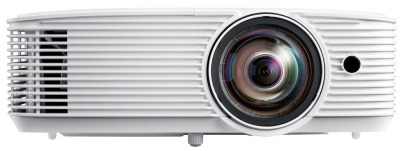 |
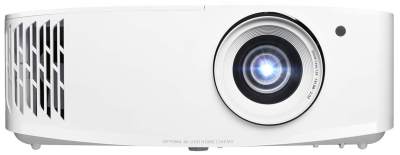 |
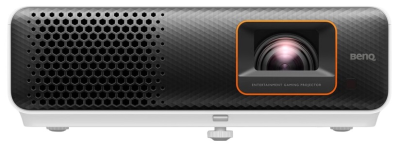 |
 |
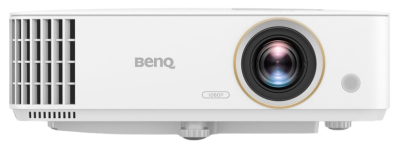 |
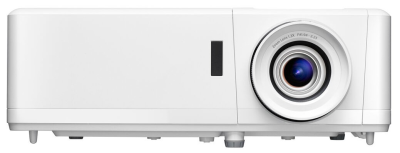 |
|
| Resolution | 1920x1080 | 3840x2160 | 1920x1080 | 3840x2160 | 1920x1080 | 3840x2160 |
| Brightness (Lumens) | 3,800 ANSI | 4,000 ANSI | 2,300 ANSI | 3,000 ANSI | 3,500 ANSI | 3,000 ANSI |
| Contrast Ratio | 50,000:1 | 1,000,000:1 | 500,000:1 | 10,000:1 | 10,000:1 | 2,500,000:1 |
| Throw Distance | 1.3' - 10.9' | 4.0' - 32.7' | 1.8' - 10.0' | 2.4' - 19.6' | 3.2' - 24.6' | 4.0' - 26.6' |
| Screen size | 36" - 307" | 33" - 300" | 30" - 200" | 30" - 300" | 30" - 300" | 34" - 303" |
| Input Lag | 8.4ms | 4.2ms | 8.3ms | 4ms | 8.3ms | 4ms |
| Speakers | 10.0 Watts Mono | 10.0 Watts Mono | 5.0 Watts × 2 | 5.0 Watts Mono | 5.0 Watts Mono | 10.0 Watts × 2 |
| Price | BHPhotoVideo.com | ProjectorScreen.com | BHPhotoVideo.com | ProjectorScreen.com | BHPhotoVideo.com |
Input Lag
Also called input latency, input lag is a measure of the delay between the user’s input on the controller and seeing that action on the screen. Anything under 60ms is considered acceptable for casual gamers. Serious players look for an input lag of 30ms or lower—and, obviously, the lower, the better.
All of the projectors below register an input lag of 8.4ms or below, and are suitable for use by even competitive gamers. The Optoma UHD38 is impressive, with an input lag as low as 4.2ms for full HD content.
The BenQ TK700STi and Optoma UHZ50 beat it out by a hair with a 4ms input lag, which is as close to instant as you’ll find from a projector.
Lowest input lag: BenQ TK700STi, Optoma UHZ50
Frame Rate
Where input lag tells you how long the signal takes to reach the screen, the frame rate determines how well that movement is represented on the screen. A low frame rate can lead to choppiness, blurriness, and other issues that can be frustrating when you’re playing.
All of the projectors below offer at least a 120Hz refresh rate for Full HD content. The BenQ TK700STi, Optoma UHZ50, and Optoma UHD38 all double this with a 240Hz frame refresh rate for full HD.
All three also have a 60Hz refresh rate for 4K content, the fastest that’s possible with current A/V equipment.
Highest frame rate: BenQ TK700STi, Optoma UHZ50, Optoma UHD38
Image Quality
Most people talk about a projector’s image quality in a home theater context, but this can be just as important for gaming. A sharp, accurate picture with high detail and clarity makes it easier to spot enemies and loot.
High contrast is especially important for games, especially those in the horror genre and other games with lots of dark areas.
For the ultimate image quality, you want to look for a 4K resolution, which you’ll get from three of the projectors below. Both the Optoma UHD38 and Optoma UHZ50 have a high image quality for movies, with a strong color gamut and contrast to match their Ultra HD resolution.
For gamers, however, the multiple game display modes of the BenQ TK700STi give it the edge, ensuring rich black levels and good detail in shadows for RPGs or first-person shooters, with excellent realism and smooth action for sports games.
Best image quality: BenQ TK700STi
Brightness
Unless you want to game in the dark, you’ll need a projector that can compete with ambient light. While you can get away with as little as 1,500-2,000 lumens in low light levels, a brightness of 3,000 lumens or higher is recommended for the typical light level in a living room or similar space.
There are three projectors on this list ideal for well-lit spaces. The BenQ TH685P produces 3,500 lumens, plenty for all but the brightest indoor spaces.
With the Optoma GT1080HDRx you’ll get 3,800 lumens and a short throw distance, giving it a lot of space versatility as well as maximizing its brightness.
For the brightest option on the list, though, you want the 4,000 lumens of the Optoma UHD38, which is powerful enough to keep the image clear and saturated even in daytime sunlight.
Brightest projector: Optoma UHD38
Optoma GT1080HDRx
The Optoma GT1080HDRx is a compact, user-friendly, and affordable way to game on the big screen. It’s one of the best gaming projectors you’ll find for under $1,000, matching the single-digit input lag of projectors that cost twice as much or more.
This is paired with a 120Hz frame refresh rate for smooth on-screen action and sharp HDR contrast to see every detail, even in shadowy areas of the game world.
We also appreciate how flexible the Optoma GT1080HDRx is to install. It has a short throw distance, filling a 100-inch screen with less than 4 feet of distance, so you don’t need a huge open space to enjoy it.
You also won’t need to turn the lights out or cover the windows thanks to the powerful lamp. It’s also quite compact, weighing just 6.6 pounds, opening up the potential to use it as a portable projector and take your gaming on the go.
The main thing you’ll sacrifice to get this responsiveness and convenience at such a great value is the image resolution. While the GT1080HDRx accepts 4K content, it has a maximum display resolution of 1080p.
This isn’t an issue for a purely gaming projector since few games are available in 4K anyway, but can be a concern if you also want to use it for movies and TV.
Pros
- High-contrast Full HD image
- Single-digit input lag
- Bright lamp for lights-on viewing
- Short throw distance
- Compact and lightweight
- Accepts 4K and 3D content
Cons
- 4K content is downscaled to 1080p
- No wireless connectivity
More detailed Optoma GT1080HDRx review
Optoma UHD38
The Optoma UHD38 uses a DLP display with XPR technology that produces the full 8.3 million on-screen pixels of true Ultra HD resolution. This sharp detail isn’t only for 4K content, either, thanks to its upscaling technology for lower-resolution content.
The Dynamic Black contrast gives the display rich black levels, with Rec.2020 and HLG support for accurate, realistic color. You can tailor the display to meet your needs with picture modes including Normal, Bright, Film, and Detail.
The responsiveness of the Optoma UHD38 is its main strength for gamers. Its input lag for 1080p content is in the single digits, with a high 240Hz refresh rate for smooth on-screen action.
The lag is still very reasonable for 4K content, at 16.7ms, on par with other high-end gaming projectors.
With its 4,000-lumen lamp, the Optoma UHD38 can maintain a high picture quality even in bright spaces. It is a standard throw projector so will need a larger space, and its installation flexibility is unfortunately somewhat limited.
It does have 4-corner geometric correction but the zoom is narrow and there are no options like lens shift to help align the image.
Pros
- Super-low input lag with high frame refresh rate
- High-contrast true 4K image with HDR and HLG support
- Upscales lower resolution content to near-4K
- Multiple picture modes to fine-tune the image
- Bright lamp works in any viewing space
- Four-corner keystone correction
Cons
- No built-in wireless connectivity or streaming
- Long throw distance with limited image adjustment options
BenQ TH690ST
The BenQ TH690ST pairs its DLP display with an LED light source, and that has both advantages and downsides for buyers. On the plus side it produces exceptional image color, with coverage for 98% of the Rec.709 color gamut that combines with the high dynamic contrast for stunningly lifelike images.
The downside of this is it’s not very bright, producing around 2,300 ANSI lumens. This can compete with low levels of ambient light, but may get washed out in brighter spaces.
Aside from the light level, the BenQ TH690ST is very flexible to install. It has a short throw distance that can produce a clear image with less than two feet of space.
A 1.2x zoom and 2D keystone correction add more options for easily aligning the image to the screen, and it’s small and durable enough to take with you on road trips, or back and forth from home to your dorm room.
Even competitive gamers will have no complaints about the responsiveness of the BenQ TH690ST, thanks to its 8.3ms input lag and 120Hz frame refresh rate.
The Full HD resolution will also be fine for gaming, especially considering the wide color gamut and high contrast. It also does accept 4K content, though downscaled to 1080p.
Pros
- Responsive enough for competitive gamers
- Excellent color and contrast
- Flexible to install with short throw distance
- Durable and portable
- Accepts content up to 4K
- Supports 3D content from most sources
Cons
- Not suitable for bright spaces
- 4K content is downscaled to 1080p
Our in-depth review of the BenQ TH690ST
Optoma UHZ50
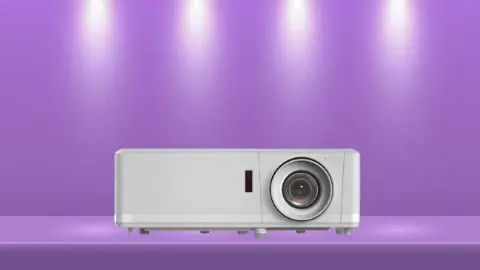 Here is another highly responsive projector from Optoma. In Enhanced Gaming Mode, the UHZ50 has an input lag of only 4ms in full HD, with a fast 240Hz refresh rate, with a 60Hz frame rate and 16.7ms input lag in 4K.
Here is another highly responsive projector from Optoma. In Enhanced Gaming Mode, the UHZ50 has an input lag of only 4ms in full HD, with a fast 240Hz refresh rate, with a 60Hz frame rate and 16.7ms input lag in 4K.
The Optoma UHZ50 uses a laser phosphor light source that has a long lifespan and produces sharp, bright, and vibrant images.
Like other Optoma projectors, it uses a DLP display with support for HLG and HDR content, with exceptional dynamic contrast and enough brightness to maintain that picture even when you leave the lights on.
While the UHZ50 isn’t quite a short-throw projector, it needs less space than most standard-throw projectors, producing a 100-inch image from as little as 8’9” away.
It also has a 10% vertical lens shift, 2D keystone correction, and a 1.3x manual zoom, giving it a fast and easy overall installation.
On the connectivity side, the option of wireless streaming, combined with 3 HDMI inputs, give users lots of options for how they get their content. For our more in-depth review of this projector, click here.
Pros
- High image quality
- Super-low lag in Enhanced Gaming Mode
- Wireless connectivity with built-in streaming
- Flexible installation with reasonable throw distance
- Bright enough for most indoor environments
- Speakers have good output and sound quality
Cons
- Costs more than most projectors on the list
BenQ TH685P
The BenQ TH685P is another great option for gamers on a budget. For around $700, you’ll get an 8.3ms lag with a 120Hz refresh rate.
Activating Game Mode also adjusts the image, enhancing the detail in dark areas of the screen, and it has a game sound mode to pair with these image adjustments.
The BenQ TH685P has a standard throw lens and needs around 9-10 feet of distance to fill a 100-inch screen. Its image correction features make it flexible and easy to install, with vertical lens shift and automatic keystone correction as well as a 1.3x zoom.
It will also work well in a variety of light levels, with a 3,500-lumen lamp that maintains a clear image in any indoor environment and can also go outside before full dark.
As you might expect for the price, the maximum resolution produced by the TH685P is Full HD, and it can’t play 4K content, which could be an issue in modern home theaters. It also lacks wireless connectivity or smart features that many users today look for.
On the plus side, it can play 3D content from any source, with support for the 4 major 3D formats in use today (frame sequential, frame packing, side-by-side, and top-bottom).
Pros
- Excellent responsiveness for gaming
- Strong color with sharp image contrast
- Powerful lamp works well even in bright rooms
- Flexible to install
- Supports all 3D content formats
- Great value for the money
Cons
- Standard throw distance
- No wireless or 4K content support
Our in-depth review of the BenQ TH685P
BenQ TK700STi
BenQ is a leading name in gaming projectors, and their TK700STi is a top choice for serious players. This starts with its responsiveness, with a 240Hz refresh rate and low 4ms input lag that let you get fully immersed in your game with no delays or other issues.
You can also optimize the display to match your style of play, with dedicated picture modes for first-person shooters, sports games, and RPGs that enhance the detail and realism.
We also appreciate the flexibility of the BenQ TK700STi. Its 3,000-lumen lamp is bright enough to use in most spaces and it has a short throw distance, producing a 100-inch image with around 6.5-7 feet between the lens and screen.
Combined with its 2D keystone correction and 1.2x zoom, this makes it fairly easy to install in any home.
The BenQ TK700STi comes with an Android TV dongle that gives it direct streaming capability. However, you will need to use one of the 2 HDMI inputs for this, which may be an issue for more complex set-ups.
This is also a projector you’ll definitely want to use external speakers with. The 5-watt speaker that’s built-in is on-par with most laptop speakers in its sound quality and volume output, not ideal for gaming and movies.
For our more in-depth review of the BenQ TK700STi, click here.
Pros
- Dedicated picture modes for RPGs, FPS, and sports games
- Low input lag with high frame refresh rate
- 4K resolution
- Full coverage of Rec.709 color spectrum
- Short throw distance
- Android TV dongle for streaming
Cons
- Limited image adjustment options
- Weak built-in speaker
So What’s the Best Gaming Projector?
Deciding on the best gaming projector is ultimately a personal and subjective decision. We’d say that the TK700STi currently is the best gaming projector (>>> Check on Projectorscreen).
That’s not to say it wins every category, however. The Optoma UHD38 has a bright lamp perfect for indoor/outdoor use, while the BenQ TH685P and Optoma GT1080HDRx represent the best value on the list.
We hope this review has helped you decide which one best fits your needs!
